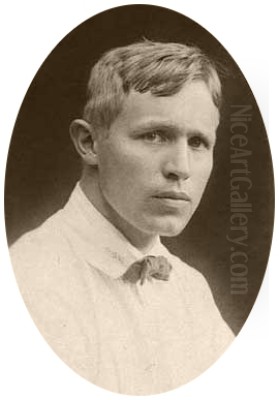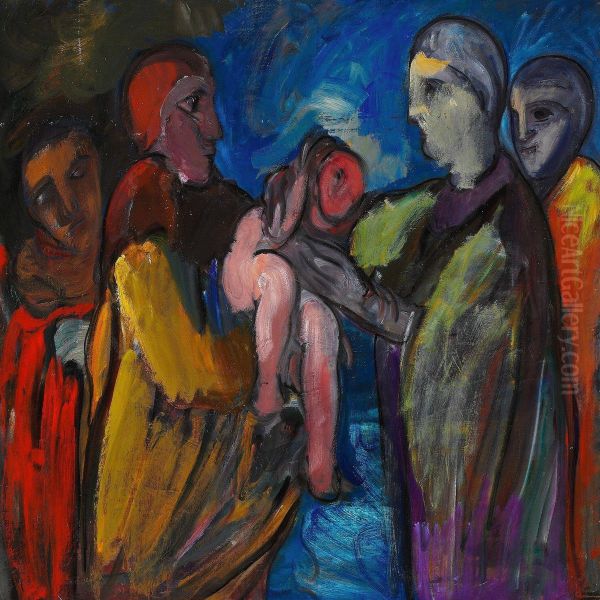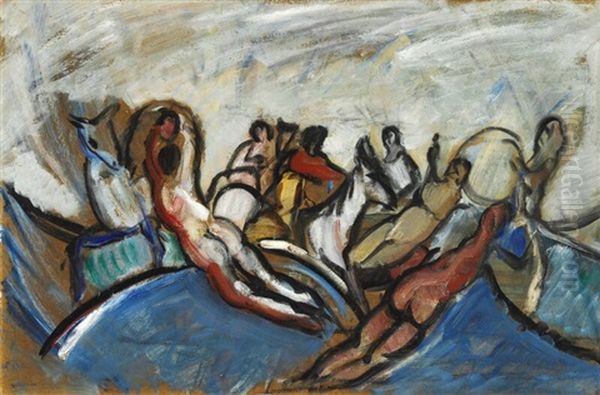
Jens Adolf Emil Jerichau, often referred to as J.A.E. Jerichau, stands as a poignant and incandescent figure in the annals of Danish art history. His life, tragically cut short at the tender age of twenty-five, was a whirlwind of prodigious talent, intense artistic exploration, and profound personal struggle. In a career that spanned little more than half a decade, Jerichau produced a body of work that not only bridged the classical traditions with the burgeoning forces of modernism but also left an indelible mark on subsequent generations of Scandinavian artists. His paintings, characterized by their vibrant color, dynamic compositions, and deeply felt emotionality, continue to resonate with a raw power and an unsettling beauty. This exploration delves into the life, work, and enduring legacy of an artist whose brief flame burned with an astonishing brilliance.
A Legacy of Art: Family and Early Formation
Born on April 17, 1890, in Assens, Denmark, Jens Adolf Emil Jerichau was practically destined for a life in the arts. He was the scion of one of Denmark's most prominent artistic families. His father, Jens Adolf Jerichau (1816-1883), was a highly respected sculptor of the Danish Golden Age, known for works like "The Panther Hunter" and his neoclassical style, heavily influenced by his time in Rome and his association with the legacy of Bertel Thorvaldsen. His mother, Elisabeth Jerichau-Baumann (1819-1881), was a successful and internationally recognized painter, born in Poland and trained in Germany, celebrated for her portraits, genre scenes, and Orientalist themes. Though both parents passed away before or shortly after his birth, their artistic reputations and the environment they cultivated undoubtedly shaped the young Jerichau's path.
The artistic lineage extended to his siblings. His elder brothers, Harald Jerichau (1851-1878), a gifted landscape and marine painter whose life was also tragically short, and Holger Hvitfeldt Jerichau (1861-1900), known for his atmospheric landscape paintings, particularly of Italian and Oriental scenes, further cemented the family's artistic identity. Growing up in such an environment, surrounded by art and the stories of artistic endeavor, must have provided a powerful, if perhaps daunting, inheritance for the young Jens Adolf Emil.

His formal artistic education began with drawing lessons under the architect Christian Vilhelm Nielsen, a common foundational step for aspiring artists at the time. In 1868, according to some records (though this date seems problematic given his 1890 birth, perhaps referring to an earlier family member or a misattribution, but it's noted in the source material for his education), he entered the Royal Danish Academy of Fine Arts in Copenhagen to study perspective. He later took lessons from Frederik Christian Lund, a painter known for his historical and genre scenes. However, Jerichau's temperament was perhaps not suited to the rigid structures of academic training; he did not complete his studies at the Academy, a path not uncommon for artists who sought a more personal and innovative mode of expression.
The Crucible of Copenhagen and the Allure of Paris
Copenhagen at the turn of the 20th century was a city experiencing the currents of change, and its art scene was no exception. While the legacy of the Danish Golden Age, with figures like Christoffer Wilhelm Eckersberg and Christen Købke, still held sway, new influences were beginning to emerge. Jerichau's early development was significantly shaped by his friendship with the art historian Vilhelm Wanscher. Wanscher, a proponent of the "grand style," introduced Jerichau to the monumental traditions of the Renaissance and Baroque masters, encouraging him to study artists like Michelangelo, Titian, and El Greco. This classical grounding provided Jerichau with a strong sense of form and composition, even as he began to push against its conventions.
A pivotal moment in Jerichau's artistic journey was his visit to Paris in 1912. The French capital was then the undisputed epicenter of the avant-garde. Here, Jerichau encountered firsthand the revolutionary movements that were reshaping European art: Fauvism, with its explosive use of color by artists like Henri Matisse and André Derain; Cubism, with its fragmented forms and multiple perspectives pioneered by Pablo Picasso and Georges Braque; and the enduring legacy of Post-Impressionists like Paul Cézanne, whose structural approach to painting was profoundly influential.
Jerichau was particularly captivated by the work of Picasso. He reportedly had a brief meeting with the Spanish master and was deeply impressed by his innovative spirit. This exposure to modernism was transformative. It ignited in Jerichau a desire to synthesize the grandeur of classical art with the expressive freedom and bold chromatic experimentation of his contemporaries. He sought a visual language that could convey both timeless themes and the intensity of modern experience. He also formed a friendship with the Danish artist Axel Salto, a significant figure in Danish modernism known for his ceramics and graphic work, and reportedly invited Salto to join him for a period of work in Brittany, a region popular with artists for its rugged landscapes and distinctive culture.
An Evolving Style: Color, Form, and Expression

Returning to Denmark, Jerichau embarked on a period of intense artistic production. His style became a unique fusion of classical figuration and modern expressive tendencies. While his subjects often drew from mythology, the Bible, and historical allegories – themes aligned with the "grand style" – his treatment of these subjects was anything but conventional. He prioritized color as a primary expressive tool, often allowing it to dictate the emotional tone and even the structure of his compositions. His brushwork became more vigorous and spontaneous, imbuing his figures with a sense of dynamism and raw energy.
Jerichau was less concerned with achieving a polished, academic finish than with conveying the emotional core of his subject. This led to some critics deeming his works "unfinished," but for Jerichau, the development of color and the capture of a vital expressive force were paramount. His approach can be seen as a form of early Danish Expressionism, though he maintained a stronger connection to figurative representation than many of his German Expressionist contemporaries like Ernst Ludwig Kirchner or Emil Nolde.
His paintings often feature dramatic, swirling compositions and a heightened, almost incandescent palette. There's a palpable tension in his work, a sense of struggle and yearning that likely mirrored his own inner turmoil. He wrestled with the legacy of the old masters while simultaneously embracing the radical possibilities of the new, creating a dialogue between past and present that was both deeply personal and artistically groundbreaking for the Danish context.
Masterworks of a Brief Career
Despite the brevity of his artistic output, Jens Adolf Emil Jerichau created several works that are now considered landmarks of Danish modern art. Each piece reveals different facets of his evolving style and thematic preoccupations.
_Greeks_ (1913): Created shortly after his Paris sojourn, this work demonstrates his engagement with classical themes through a modern lens. The figures, while recognizably human, are rendered with a certain stylization and a focus on rhythmic composition. The colors are vibrant, hinting at the Fauvist influences he had absorbed.
_Fremstillingen i Templet_ (Presentation in the Temple, 1914): This painting tackles a traditional biblical scene but infuses it with a dramatic intensity and a bold use of color that moves beyond academic convention. The emotional weight of the moment is conveyed through expressive figures and a dynamic interplay of light and shadow, possibly showing an awareness of German Expressionist currents.
_Standing Salome_ (1915): The figure of Salome, a popular subject for artists exploring themes of desire and danger, is rendered with a characteristic Jerichau intensity. The work likely combines his interest in biblical narratives with an exploration of powerful, almost primal, female figures.
_The Coming of Spring_ (1915): Described as a poster, this work, with its themes drawn from biblical and art historical figures, showcases his capacity for strong, graphic statements. It likely embodied the "wildness and spontaneity" that critics noted in his more expressionistic pieces.
_Havguds_ (The Sea God/Neptune, 1916): Perhaps his most famous and accomplished work, _Havguds_ is a monumental and dynamic painting. It depicts a powerful sea god amidst turbulent waves, a maelstrom of blues, greens, and whites. The figure of the god is muscular and energetic, reminiscent of Baroque masters, yet the overall treatment of color and form is distinctly modern. The swirling, almost abstract quality of the water showcases Jerichau's mastery of color to convey movement and raw natural force. It is a powerful testament to his ambition to create a modern "grand style."
_Palm Tree Landscape_ (1916): This work indicates his engagement with landscape painting, likely imbued with the same expressive color and dynamic composition found in his figurative works. The exotic subject might also hint at a romantic or escapist yearning.
These works, created in a remarkably short span, illustrate Jerichau's rapid development and his unique ability to synthesize diverse influences into a coherent and powerful personal vision. He was not merely imitating; he was transforming his sources, forging a new path for Danish art.
Personal Turmoil and Tragic End
Jens Adolf Emil Jerichau's intense artistic output was paralleled by significant personal struggles. He reportedly battled with mental health issues, a burden that would have been immensely challenging in an era with limited understanding and treatment for such conditions. Furthermore, he grappled with aspects of his personal life, including an "unconventional love" that may have faced societal disapproval, adding to his emotional strain.
The pressure of his artistic ambitions, combined with his inner demons and the complexities of his personal life, proved overwhelming. On August 16, 1916, in Paris, Jens Adolf Emil Jerichau died by suicide. He was only twenty-five years old. His death was a profound loss for Danish art, silencing a voice that was just beginning to articulate its full power and potential. The tragic circumstances of his passing inevitably cast a shadow over his work, adding a layer of poignancy to his already emotionally charged paintings.
Enduring Legacy and Posthumous Recognition
Despite his tragically short life, Jens Adolf Emil Jerichau's impact on Danish art was significant and lasting. He is often seen as a pivotal figure in the transition from traditional Danish painting to modernism. His bold use of color, his expressive intensity, and his willingness to experiment with form opened up new possibilities for Danish artists.
His influence is particularly evident in the work of later generations of Danish painters. Asger Jorn (1914-1973), a leading figure in the CoBrA movement and one of Denmark's most internationally renowned artists, acknowledged Jerichau's importance. Jorn's own expressive and often mythically-charged paintings share a certain spiritual kinship with Jerichau's work. Per Kirkeby (1938-2018), another major Danish artist known for his geological and abstract landscapes, also found inspiration in Jerichau's legacy, particularly in his synthesis of structure and expressive color.
Jerichau's work was not forgotten after his death. It has been featured in numerous exhibitions, including significant retrospectives that have helped to solidify his reputation. A major exhibition at the Louisiana Museum of Modern Art in Humlebæk, Denmark, for instance, played a crucial role in re-evaluating and celebrating his contribution to Danish art history. His paintings continue to be sought after by collectors and are held in major Danish museum collections, including the Statens Museum for Kunst (National Gallery of Denmark).
The art world of his time included many other notable figures, both in Denmark and internationally, who formed the backdrop to his development. In Denmark, artists like Vilhelm Hammershøi, known for his quiet, enigmatic interiors, represented a different, more subdued strand of modernism. Contemporaries like Edvard Weie and Harald Giersing were also key figures in the development of Danish modernism, each exploring color and form in their own distinct ways. Internationally, the towering figures of Matisse, Picasso, and the German Expressionists like Kirchner, Nolde, and Franz Marc were reshaping the artistic landscape, and Jerichau, through his travels and studies, was keenly aware of these developments. His unique contribution was to filter these international currents through his own intense sensibility and his grounding in classical art, creating something uniquely Danish yet universally resonant.
A Singular Vision
Jens Adolf Emil Jerichau remains a compelling and somewhat enigmatic figure. His art is a testament to a prodigious talent grappling with immense artistic and personal challenges. He stood at a crossroads, looking back to the grandeur of the past while boldly forging a path into the modern era. His paintings are not always comfortable; they are often imbued with a sense of restlessness, a raw emotional power that can be both exhilarating and unsettling.
His focus on color as an independent expressive force, his dynamic compositions, and his reinterpretation of classical and mythological themes through a modern, expressionistic lens set him apart. He was a bridge figure, connecting the rich traditions of Danish art with the burgeoning international avant-garde. Though his career was a brief, meteoric flash, the light it cast continues to illuminate the landscape of Danish art. Jens Adolf Emil Jerichau's legacy is that of a visionary artist who, in a few short years, dared to paint his soul, leaving behind a body of work that remains as vital and challenging today as it was a century ago. His story is a poignant reminder of the fragility of genius and the enduring power of art to transcend even the most tragic of circumstances.